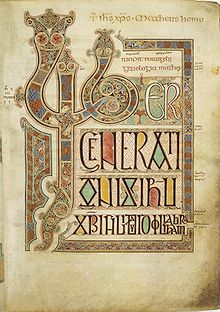Eadfrith von Lindisfarne
Eadfrith von Lindisfarne (auch Edfrid; † 721) war ein angelsächsischer Heiliger und von 698 bis zu seinem Tod Bischof von Lindisfarne.
Leben
Über Eadfriths frühe Jahre ist nichts bekannt.
Nachdem er 698 zum Bischof ordiniert worden war, unterstützte Eadfrith den Kult um Cuthbert und ließ zwischen 699 und 705 eine Hagiographie von einem anonymen Autor erstellen. Um 720 veranlasste er Beda Venerabilis, das Buch über Das Leben des heiligen Vater Cuthbert zu überarbeiten und eine Lyrik- sowie eine Prosafassung zu schreiben.[1][2]
Ein Nachwort in den Lindisfarne Gospels aus dem 10. Jahrhundert bekundet, dass Eadfrith das Werk als Schreiber und Illustrator "mit eigener Hand"[1] verfasst hat. Das aufwändige Werk entstand nach Meinung etlicher Historiker vor seiner Amtszeit als Bischof, während andere Historiker es als Auftragsarbeit Eadfriths ansehen. Wieder andere halten seine Beteiligung an dem Werk insgesamt für eine unglaubwürdige Überlieferung.[3]
Eadfrith ließ die baufällig gewordene Einsiedelei Cuthberts auf den Farne-Inseln neu errichten, die zu dieser Zeit von dem Eremiten Felgild bewohnt wurde.[1]
Eadfrith starb im Jahr 721. Sein Festtag ist der 4. Juni.
Im Jahr 875 verließ Bischof Eardulf mit den Mönchen aus Furcht vor Wikingerüberfällen das Kloster auf Holy Island. Sie nahmen die sterblichen Überreste der Heiligen Cuthbert, Eadberht, Eadfrith und Æthelwald mit nach Durham. 998 weihten die Mönche eine steinerne Kirche als Ruhestätte der Heiligen.
Quellen
- Beda Venerabilis, Das Leben des heiligen Vater Cuthbert
- Symeon von Durham, History of the Church of Durham
Weblinks
- Symeon von Durham, Übersetzer: J. Stevenson: The Historical Works of Simeon of Durham. In: Church Historians of England, volume III, part II. Seeley’s. 1855. Abgerufen am 3. Oktober 2009.
Einzelnachweise
- ↑ a b c History of the Church of Durham, Kap. XI
- ↑ Beda Venerabilis, Historia ecclesiastica gentis Anglorum, Buch V, Kap. XXIV
- ↑ Argumente für Eadfrith's Urheberschaft: Thacker, "Eadfrith"; Blair, Introduction to Anglo-Saxon England, pp. 316–317; Blair, World of Bede, p. 230. Andere Sichtweisen: Brown, "Lindisfarne Gospels"; Alcock, Kings and warriors, pp. 304–305 & 308.
| Vorgänger | Amt | Nachfolger |
|---|---|---|
| St. Eadberht | Bischof von Lindisfarne 698–721 | St. Æthelwald |
| Personendaten | |
|---|---|
| NAME | Eadfrith von Lindisfarne |
| ALTERNATIVNAMEN | Edfrid von Lindisfarne |
| KURZBESCHREIBUNG | angelsächsischer Heiliger, Bischof von Lindisfarne |
| GEBURTSDATUM | 7. Jahrhundert |
| STERBEDATUM | 721 |
Auf dieser Seite verwendete Medien
Folio 27r from the Lindisfarne Gospels, incipit to the Gospel of Matthew. The main text contains the first sentence of the Gospel According to Saint Matthew: "Liber generationis Iesu Christi filii David filii Abraham" ("The book of the generation of Jesus Christ, the son of David, the son of Abraham").
The first line contains the word "liber" ("the book") with illuminated letters in insular majuscule; the first three letters ("lib") are much more ornate than the last two ("er") in white. The next two lines are in runic capitals (i.e. Latin letters in a rune-inspired script, also seen in the Book of Nunnaminster for example): the first of these lines partially contains the word "generationis" ("generation" in the genitive case) as "-onis" appears in the next line, followed by the contracted form of "Iesu", namely "Ihu" with a tilde on the "h"; this type of contraction is called a nomen sacrum.
The last line is in insular majuscule and begins with another nomen sacrum, the contraction "χρi" with a tilde, meaning "Christi". This is followed by a more compressed series of words. The first is "filii" ("son", genitive) with an "fi" ligature and a letter "l" with two stacked "i" letters on its leg. Then "David" is seen and is formed with a letter "d" with an "a" stacked on a "v" in its counter followed by "id". After that, "filii" is present again, however this time the "fi" ligature is replaced with the Greek letter phi (φ) due to its phonetic similarity. The last word is "Abraham", which is split into two lines.
